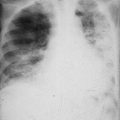and Karl Reinhard Aigner3
(1)
Department of Surgery, The University of Sydney, Mosman, NSW, Australia
(2)
The Royal Prince Alfred and Sydney Hospitals, Mosman, NSW, Australia
(3)
Department of Surgical Oncology, Medias Clinic Surgical Oncology, Burghausen, Germany
In this chapter you will learn about:
Symptoms
Investigations
Pathology
Treatments
Mesothelioma
Metastatic cancer in the lung
Cancer of the lung has increased from being an uncommon disease 100 years ago to one that, in the Western world, now causes more deaths than any other cancer. Worldwide, about one million cases are diagnosed every year, and the reported death rates are about 90 % of the diagnosis rates. This rapid increase in incidence is directly related to the widespread habit of cigarette smoking. The disease in smokers is eight to ten times more common than in non-smokers. With greater numbers of females smoking in recent years, the incidence of lung cancer in women is now approaching that of men. In the United States, other than skin cancer, lung cancer is now the second most common cancer in both sexes together. In fact, in the United States, lung cancer now causes more cancer deaths than all colorectal, breast and prostate cancers combined (see Table 2.1). The increase in numbers of people with lung cancers has followed by 20 years or more behind the increase in tobacco consumption. Due to a slowly reduced incidence of smoking in men in many Western countries (including the United States and Australia) over the last 30 years of the twentieth century, lung cancer passed its peak incidence in men between 1985 and 1990. However, it continues to rise in women, in whom smoking did not decline when it did in men.
Although tobacco smoking is by far the most significant cause of lung cancer, a number of other factors may also play a part in some cases. These include industrial and automobile pollutant gases. Workers in certain industries including chromium, arsenic and asbestos also have an increased incidence, especially if they are also smokers.
Diagnosis of lung cancers is most common in North America (especially in black males) and in New Zealand (especially in Maoris). It is also very common in the United Kingdom, Europe and Australia. It is least common in West and East Africa. It is extremely rare under the age of 30 years and is rarely diagnosed before the age of 40. Thereafter, the incidence increases with increasing age. The median age of diagnosis is between 65 and 70 years. In Western countries, it is more common in lower socio-economic groups than in higher socio-economic groups, probably because smoking is more common in lower socio-economic group.
Pathological subtypes of lung cancer. There are four major histological types of lung cancer. These are:
1.
Small-cell lung cancer (SCLC)
2.
Squamous cell cancer (SCC)
3.
Adenocarcinoma
4.
Large-cell cancer
As the approach to clinical management of the last three cancer types is similar, they are grouped together as non-small-cell lung cancers (NSCLCs). Thus for clinical and treatment purposes, lung cancer is classified as either SCLC or NSCLC.
SCLCs are generally more aggressive, and patients have a median survival time of about 18 months. Five-year survival is rare.
Localised NSCLC is potentially curable in its early stages by surgical resection, but SCLC has invariably spread beyond resectable tissues when first diagnosed.
Not only is lung cancer now showing an increase in incidence in women due to their relatively more recent uptake of smoking habit, but women with lung cancer also have a rather poorer prognosis than men with lung cancer. This is because women have a higher proportion of SCLCs and adenocarcinoma than men. Men have a higher proportion of SCCs of the lung that are relatively less aggressive and more likely to be resectable even though they are still potentially curable in less than 25 % of cases.
11.1 Symptoms
During its early stages, lung cancer causes few problems, so that it is usually not diagnosed until it is quite advanced and usually incurable. Perhaps this is partly because of the nature of the sufferer who, being a smoker, is adjusted to having a chronic cough and does not become aware of a change in the cough until the disease is advanced. A cough is the most common single symptom of lung cancer, but other features are shortness of breath, coughing up blood or bloodstained sputum (haemoptysis), chest pain and attacks of chest infection or pneumonia that do not respond completely with treatment.
Stay updated, free articles. Join our Telegram channel

Full access? Get Clinical Tree






